1994 CHEVROLET S10 recommended oil
[x] Cancel search: recommended oilPage 166 of 340

Downloaded from www.Manualslib.com manuals search engine Once you are moving on the freeway, make certain you allow a reasonable
following distance. Expect to move slightly slower at night.
When you want to leave the freeway, move to the proper lane well in
advance. If you miss your exit do not, under any circumstances, stop and
back up. Drive on to the next exit.
The exit ramp can be curved, sometimes quite sharply.
The exit speed
is usually posted.
Reduce your speed according to your speedometer, not to your s\
ense of
motion. After driving for any distance at higher speeds, you may tend to
think you are going slower than you actually are.
Before Leaving on a Long Trip
Make sure you’re ready. Try to be well rested. If you must start when you’re
not fresh
- such as after a day’s work - don’t plan to make too many
miles that first part of the journey. Wear comfortable clothing and shoes you
can easily drive in.
Is your vehicle ready for a long trip?
If you keep it serviced and maintained,
it’s ready to go. If it needs service, have it done before starting out. Of
course, you’ll find experienced and able service experts in Vehicle
dealerships all across North America. They’ll be ready and w\
illing to help if
you need it.
Here are some things you can check before a trip:
Windshield Washer Fluid: Is the reservoir full? Are all windows clean
inside and outside?
Wiper Blades: Are they in good shape?
Fuel, Engine Oil, Other Fluids: Have you checked all levels?
Lights: Are they all working? Are the lenses clean?
Tires: They are vitally important to a safe, trouble-free trip. Is th\
e tread
good enough for long-distance driving? Are the tires all inflated to the
recommended pressure?
Should you delay your trip a short time to avoid a major storm syst\
em?
Weather Forecasts: What’s the weather outlook along your route?
Maps: Do you have up-to-date maps?
4-30
Page 229 of 340
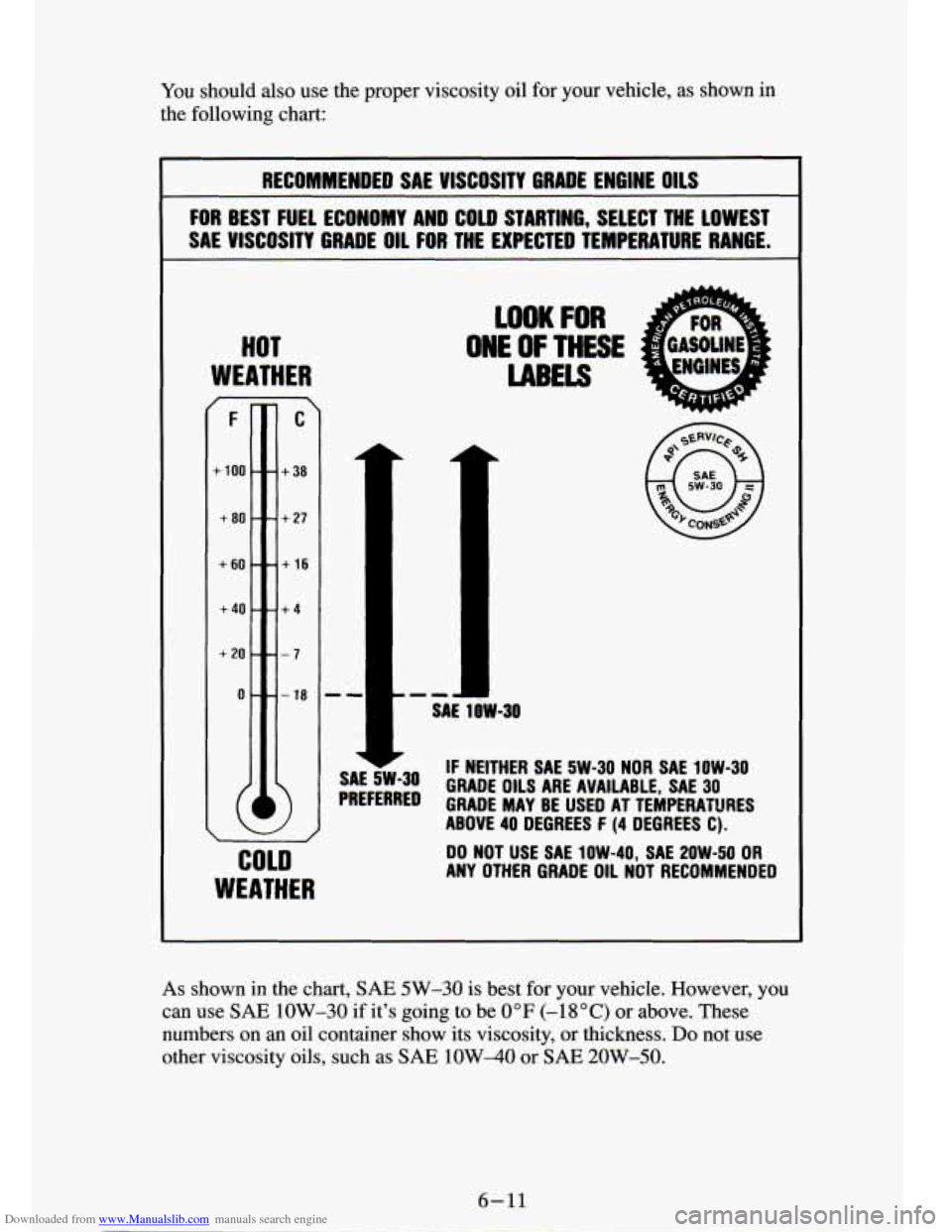
Downloaded from www.Manualslib.com manuals search engine You should also use me proper viscosity oil for your vehicle, as shown in
the following chart:
RECOMMENDED SAE VISCOSITY GRADE ENGINE OILS
FOR BEST FUEL ECONOMY AND COLD STARTING, SELECT THE LOWEST
SAE VISCOSITY GRADE
OIL FOR THE €XPECTED TEMPERATURE RANGE.
HOT
WEATHER
/F
-
+loo - -
+80 --
+60 --
+40 - -
+20 - -
O--
1
C
- +38
- + 27
- +16
-+4
- -7
- -18
COLD
WEATHER
SAE SW-30
PREFERRED
LOOK FOR
ONE OF THESE
LABELS
SA! 1OW-30
IF NEITHER SAE 5W-30 NOR SAE 1OW-30
GRADE
OILS ARE AVAILABLE, SAE 30
GRADE MAY BE USED AT TEMPERATURES
ABOVE
40 DEGRfES F (4 DEGREES C).
ANY OTHER GRADE OIL NOT RECOMMENDED
DO
NOT USE SAE 1OW-40, SAE
2OW-50 OR
As shown in the chart, SAE 5W-30 is best for your vehicle. However, you
can use
SAE 1OW-30 if it's going to be 0°F (-18 "C) or above. These
numbers on an
oil container show its viscosity, or thickness. Do not use
other viscosity oils, such as
SAE 1OW-40 or SAE 20W-50.
6-11
Page 236 of 340

Downloaded from www.Manualslib.com manuals search engine 4. If the fluid level
is in the
acceptable range,
push the dipstick
back in all the
way; then flip the
handle down to
lock the dipstick
in place.
How to Add Fluid
Refer to the Maintenance Schedule to determine what kind of transmission
fluid to use. See “Recommended Fluids and Lubricants”
in the Index.
If the fluid level is low, add only enough of the proper fluid to bring the
level up to the COLD area for a cold check or the
HOT area for a hot check.
It doesn’t take much fluid, generally less than a pint.
Don’t overfill. We
recommend you use only fluid labeled DEXRON@-I11 or DEXRON@-IIE,
because fluids with that label are made especially for your automatic
transmission. Damage caused by fluid other than DEXRON@-I11 or
DEXR0N’-IIE is not covered by your new vehicle warranty.
0 After adding fluid, recheck the fluid level as described under “How to
Check.”
0 When the correct fluid level is obtained, push the dipstick ba\
ck in all
the way; then flip the handle down to lock the dipstick in place.
Manual Transmission Fluid
When to Check
A good time to have it checked is when the engine oil is changed. However,
the fluid in your manual transmission
doesn’t require changing.
How to Check
Because this operation can be a little difficult, you may choose to have this
done at a
GM dealership Service Department.
If you do it yourself, be sure to follow all the instructions\
here, or you could get a false reading.
6-18
Page 241 of 340
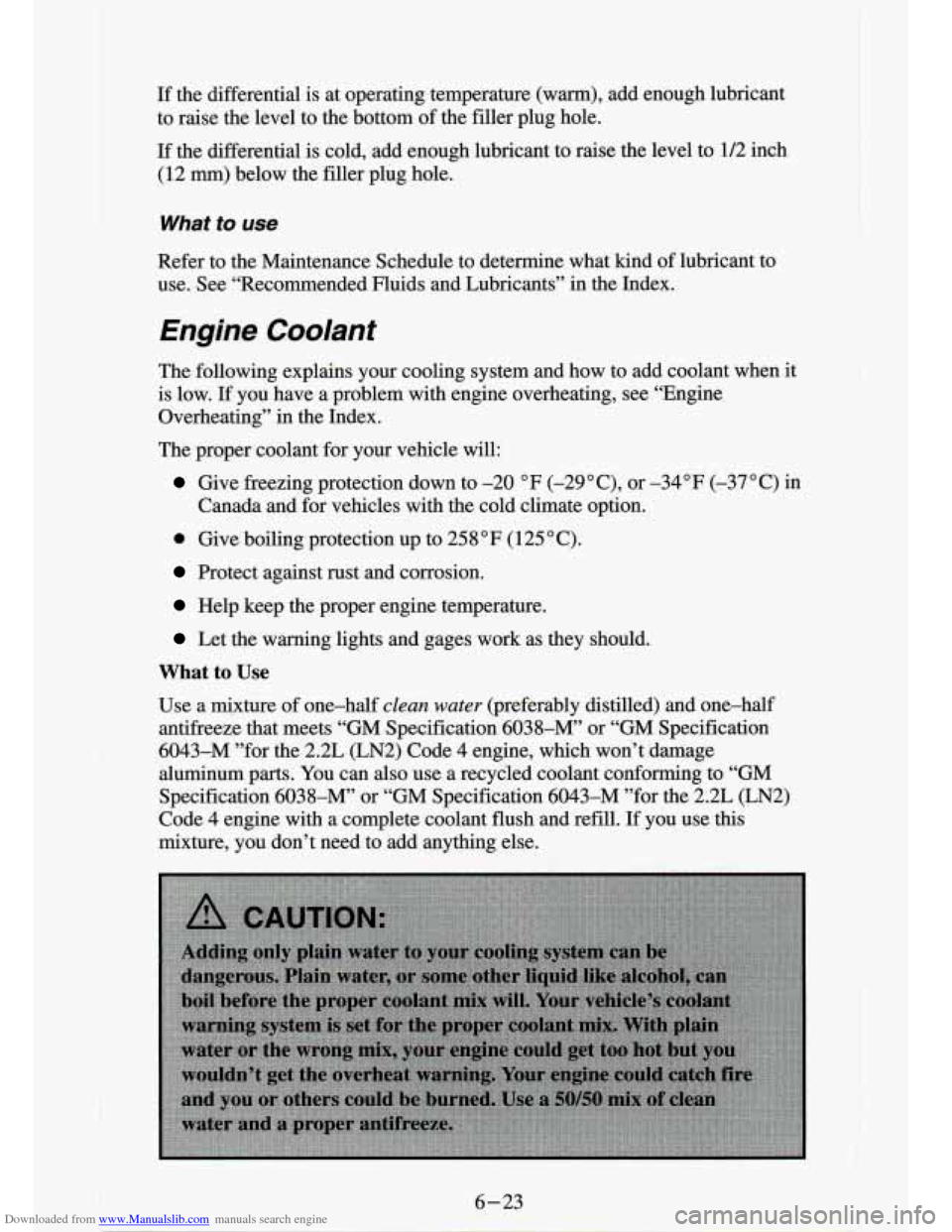
Downloaded from www.Manualslib.com manuals search engine If the differential is at operating temperature (w,arm), add enou\
gh lubricant
to raise the level to the bottom of the filler plug hole.
If the differential is cold, add enough lubricant to raise the level to 1/2 inch
(12
mm) below the filler plug hole.
What to use
Refer to the Maintenance Schedule to determine what kind of lubricant to
use. See “Recommended Fluids and Lubricants” in the Index.
Engine Coolant
The following explains your cooling system and how to add coolant \
when it
is low.
If you have a problem with engine overheating, see “Engine
Overheating” in the Index.
The proper coolant for your vehicle will:
Give freezing protection down to -20 “F (-29” C), or -34°F (-37 “C) in
Canada and for vehicles with the cold climate option.
e Give boiling protection up to 258°F (125°C).
Protect against rust and corrosion.
Help keep the proper engine temperature.
Let the warning lights and gages work as they should.
What to Use
Use a mi,xture of one-half clean water (preferably distilled) and one-half
antifreeze that meets “GM Specification 603%” or “GM Specification
6043-M ”for the 2.2L (LN2) Code 4 engine, which won’t damage
aluminum parts. You can also use
a recycled coolant conforming to “GM
Specification 603%” or “GM Specification 6043-M ”for the 2.2L (LN2)
Code 4 engine with a complete coolant flush and refill.
If you use this
mixture, you don’t need to add anything else.
6-23
Page 284 of 340
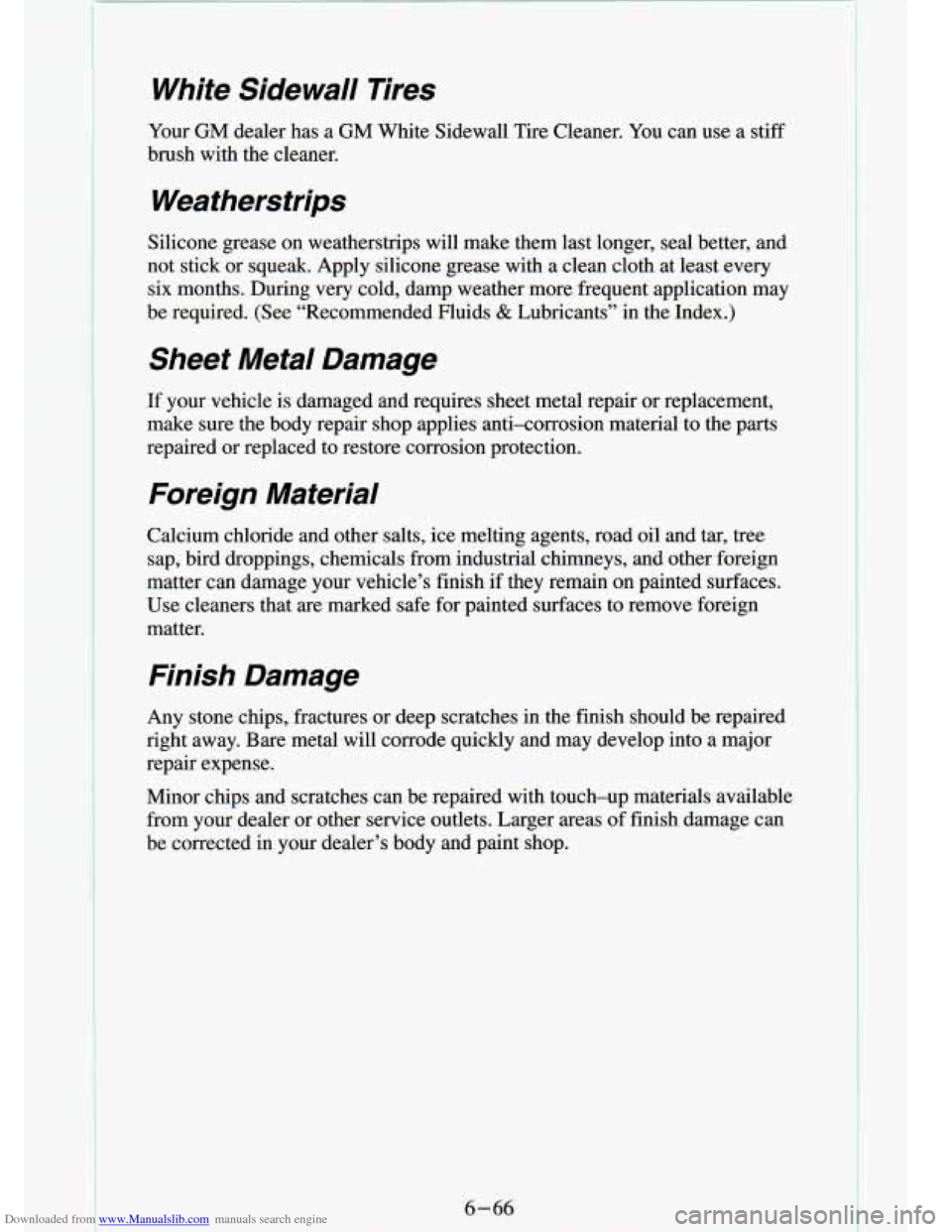
Downloaded from www.Manualslib.com manuals search engine White Sidewall Tires
..
Your GM dealer has a GM White Sidewall Tire Cleaner. You can use a stiff
brush with the cleaner.
Weatherstrips
Silicone grease on weatherstrips will make them last longer, se\
al better, and
not stick or squeak. Apply silicone grease with a clean cloth \
at least every
six months. During very cold, damp weather more frequent application\
may
be required. (See “Recommended Fluids
& Lubricants” in the Index.)
Sheet Metal Damage
If your vehicle is damaged and requires sheet metal repair or rep\
lacement,
make sure the body repair shop applies anti-corrosion material to the parts
repaired
or replaced to restore corrosion protection.
Foreign Material
Calcium chloride and other salts, ice melting agents, road oil and tar, tree
sap, bird droppings, chemicals from industrial chimneys, and other foreign
matter can damage your vehicle’s finish if they remain on p\
ainted surfaces.
Use cleaners that are marked safe for painted surfaces to remove foreign
matter.
Finish Damage
Any stone chips, fractures or deep scratches in the finish sho\
uld be repaired
right away. Bare metal will corrode quickly and may develop in\
to a major
repair expense.
Minor chips and scratches can be repaired with touch-up materia\
ls available
from your dealer or other service outlets. Larger areas of finish damage can
be corrected in your dealer’s body and paint shop.
6-66
Page 302 of 340

Downloaded from www.Manualslib.com manuals search engine MAINTENANCE SCHEDULE I/
Item Miles (000) 7.5 15 22.5 30 37.5 45 52.5 60
No. Kilometers
(000) 12.5 25 37.5 50 62.5 75 87.5 100
Service
1 Engine Oil Change*-Every 12 Months, or
Oil Filter Change*-Every
12 Months, or
2 Chassis Lubrication-Every 12 Months, or
3 Cooling System Service*
0
-Every 24 Months or
o.......
0 0 0 0
o.......
0
*
11 Fuel Tank, Cap and Lines
12 Engine Accessory Drive Belt
13 Tire and Wheel Rotation
0 0 0 0
14 Drive Axle Service OO......
15 Brake Systems Inspection**
* An Emission Control Service
** See “Explanation of Scheduled Maintenance Services” in the Index
$ The California Air Resources Board has determined that the fail\
ure to perform this Inspection*$
Inspection*
0
0
maintenance item will not nullify the emission warranty or limit recall liability prior to the
completion of vehicle useful life. General Motors, however, urges that all recommended
maintenance services be performed at the indicated intervals and the maintenance be
recorded.
THE SERVICES SHOWN ON THIS CHART
UP TO 60,000 MILES (100 000 km) ARE TO BE
DONE AFTER 60,000 MILES
AT THE SAME INTERVALS.
TO803
Page 309 of 340
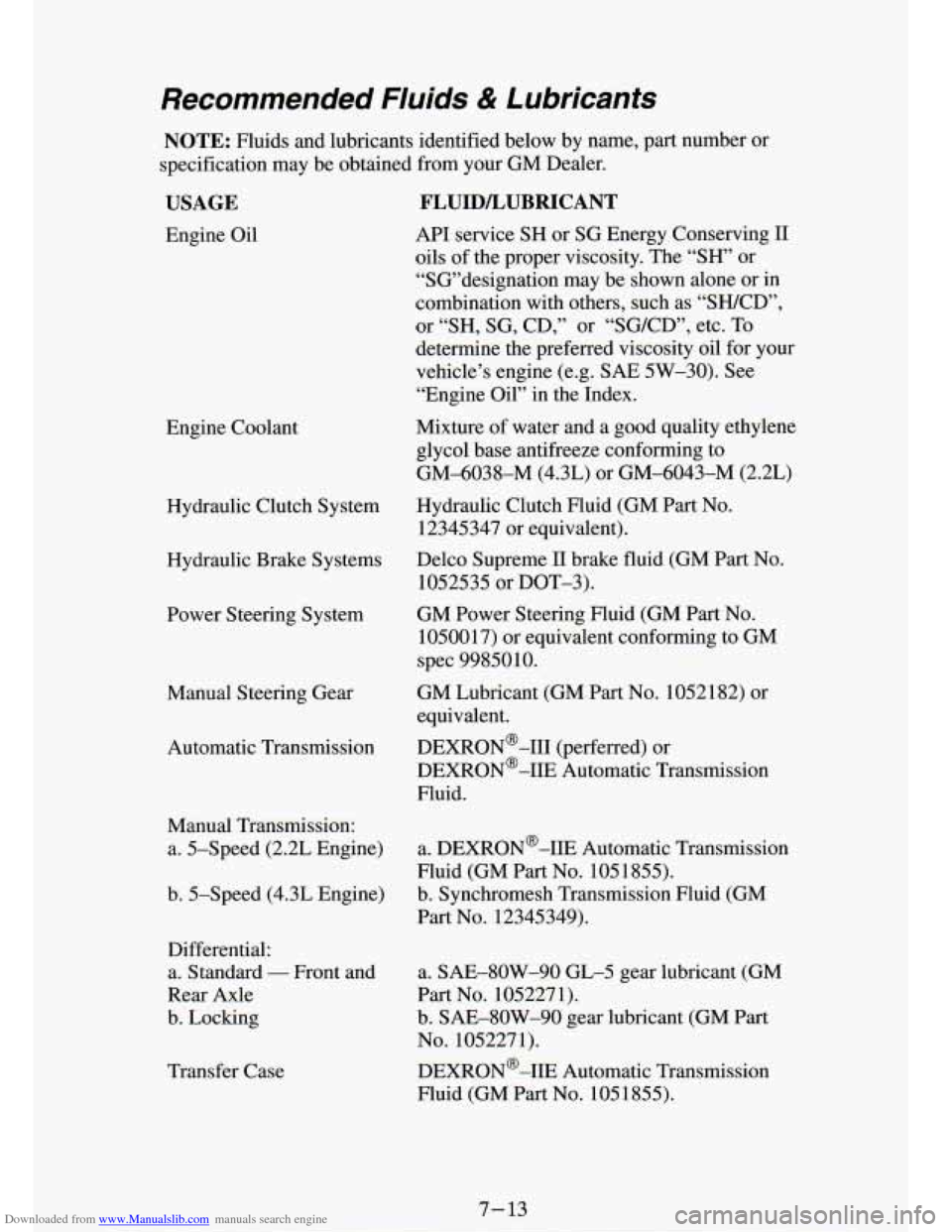
Downloaded from www.Manualslib.com manuals search engine Recommended Fluids & Lubricants
NOTE: Fluids and lubricants identified below by name, part number or
specification may be obtained
from your GM Dealer.
USAGE
Engine Oil
Engine Coolant Hydraulic Clutch System
Hydraulic Brake Systems
Power Steering System
Manual Steering Gear Automatic Transmission
Manual
Iransrmssu
a. 5-Speed (2.2L Engine)
b. 5-Speed (4.3L Engine)
FLUIDLUBRICANT
API service SH or SG Energy Conserving I1
oils of the proper viscosity. The “SH” or
“SG’designation may be shown alone or in
combination with others, such as “SH/CD”,
or “SH, SG, CD,” or “SGKD”, etc. To
determine the preferred viscosity oil for your
vehicle’s engine (e.g. SAE 5W-30). See
“Engine Oil” in the Index.
Mixture of water and a good quality ethylene
glycol base antifreeze conforming to
GM-6038-M (4.3L) or GM-6043-M (2.2L)
Hydraulic Clutch Fluid (GM Part
No.
12345347 or equivalent).
Delco Supreme
11 brake fluid (GM Part No.
1052535 or DOT-3).
GM Power Steering Fluid (GM Part No.
1050017) or equivalent conforming to GM
spec 9985010.
GM Lubricant (GM Part No. 1052182) or
equivalent. DEXRON@-III (perferred) or
DEXRON@-IIE Automatic Transmission
Fluid.
a. DEXRON@-IIE Automatic Transmission
Fluid (GM Part No. 1051855).
b. Synchromesh Transmission Fluid (GM
Part
No. 12345349).
Differential: a. Standard
- Front and a. SAE-8OW-90 GL-5 gear lubricant (GM
Rear Axle Part No. 1052271).
b. Locking b. SAE-SOW-90 gear lubricant (GM Part
No. 1052271).
DEXRON@-IIE Automatic Transmission
Fluid (GM Part No.
1051855).
Transfer Case
7 -23
Page 333 of 340
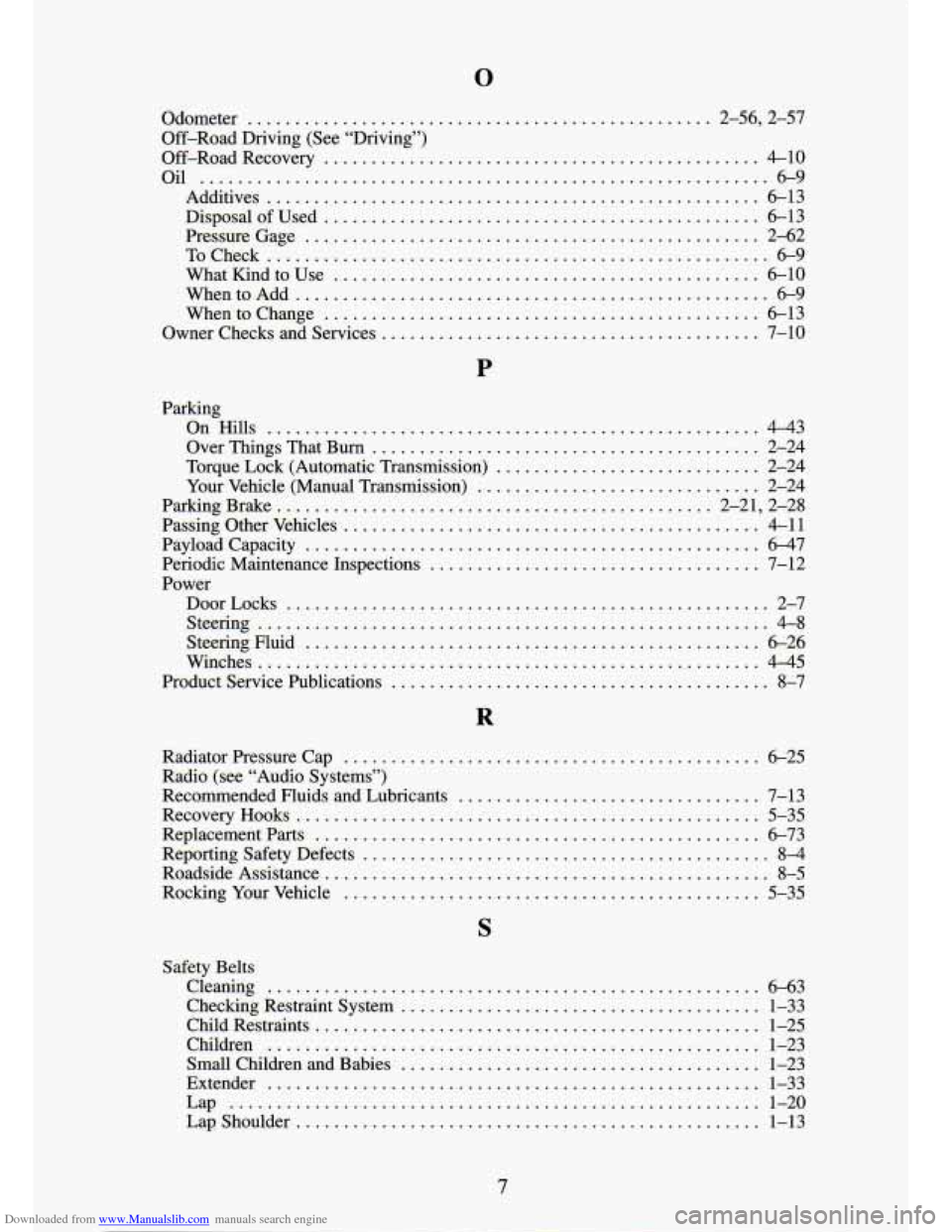
Downloaded from www.Manualslib.com manuals search engine 0
Odometer ................................... ............. 2.56. 2.57
Off-Road Driving (See “Driving”)
Off-RoadRecovery
.............................................. 4-10
Oil
............................................................ 6-9
Additives
.................................................... 6-13
DisposalofUsed
.............................................. 6-13
Pressure Gage
................................................ 2-62
ToCheck
..................................................... 6-9
WhatKindtoUse
............................................. 6-10
WhentoAdd
.................................................. 6-9
Whentochange
.............................................. 6-13
Owner Checks and Services
........................................ 7-10
Parking On Hills
.................................................... 4-43
Over Things That
Burn ......................................... 2-24
Torque Lock (Automatic Transmission)
............................ 2-24
Your Vehicle (Manual Transmission)
.............................. 2-24
ParkingBrake
.............................................. 2.21, 2.28
Passing Other Vehicles
............................................ 4-11
Payload Capacity
................................................ 6-47
Periodic Maintenance Inspections
................................... 7-12
Power DoorLocks
................................................... 2-7
Steering
...................................................... 4-8
SteeringFluid
................................................ 6-26
Winches
..................................................... 4-45
Product Service Publications
........................................ 8-7
R
Radiator Pressure Cap ...... 6-25
Radio (see “Audio Systems”)
Recommended Fluids and Lubricants
................................ 7-13
RecoveryHooks
................................................. 5-35
Replacement Parts
............................................... 6-73
Reporting Safety Defects
........................................... 8-4
Roadside Assistance ............................................... 8-5
Rocking Your Vehicle ............................................ 5-35
Safety Belts
Cleaning
.................................................... 6-63
Checking Restraint System
...................................... 1-33
ChildRestraints
............................................... 1-25
Children
.................................................... 1-23
Small Children and Babies
...................................... 1-23
Extender
.................................................... 1-33
Lap
........................................................ 1-20
Lapshoulder
................................................. 1-13
7